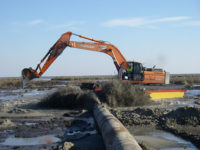Louisiana is expected to see more than $1 billion of coastal restoration work in the next two years with $489 million of projects under construction and another $600 million of projects scheduled to start by 2015.
Kyle Graham, executive director of the Coastal Protection and Restoration Authority, spoke at the State of the Coast conference in mid-March. Louisiana has been promised nearly $2 billion in Clean Water Act and criminal fines from BP and Transocean for their role in the 2010 Deepwater Horizon oil spill. Those funds, along with other sources, are expected to fuel a large number of projects in the coming years.
Projects have been outlined in the 2015 Annual Plan and include such things as constructing rock breakwaters, sediment pumping, storm proofing of pumping stations, levee enhancements and water control structures.
"We're moving forward with reconstructing marshes that have eroded or islands that have degraded over time. We're making significant investments," says Graham.
Some of the notable projects completed or that were under construction in 2013 were the Madisonville Bulkhead Project, the Caminada Headland Beach and Dune Restoration and the Lake Hermitage Marsh Creation project.
Eighteen projects are anticipated to start construction in 2014 including Jean Lafitte Tidal Protection project, Marsh Creation Near Freshwater Bayou and berm construction on Shell Island East.
Total expenditures in 2014 include $538 million for construction, $66.8 million for engineering and design and $23.3 million for planning. Graham says the Coastal Protection and Restoration Authority is also looking towards long-term solutions and innovative techniques to help restore and preserve the state's coastline.
"How do we go forward with some of the more innovative techniques and technologies work toward a sustainable coast? We're looking to form the best tools to engineer and design the solutions for tomorrow," says Graham.
Graham says the current plan of projects could be a smaller piece of up to $50 billion worth of projects in the next 50 years.


